- Joined
- Oct 15, 2020
- Messages
- 2
How would you recommend cutting an antler roll for scales as obviously its round so would be difficult to use any kind of machine to cut without altering it.
Thanks
Thanks
The BladeForums.com 2024 Traditional Knife is ready to order! See this thread for details:
https://www.bladeforums.com/threads/bladeforums-2024-traditional-knife.2003187/
Price is $300 $250 ea (shipped within CONUS). If you live outside the US, I will contact you after your order for extra shipping charges.
Order here: https://www.bladeforums.com/help/2024-traditional/ - Order as many as you like, we have plenty.
Okay, but how do you secure it ? do you just free cut it or do you make a jig to hold it and ensure a straight cut ?I use a bandsaw. Bone stinks when you’re cutting it too.
Okay, but how do you secure it ? do you just free cut it or do you make a jig to hold it and ensure a straight cut ?
Bone stinks when you’re cutting it too.
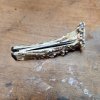
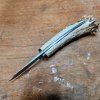
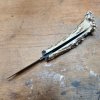 e for my "mountain Man" folders.
e for my "mountain Man" folders.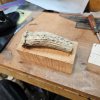

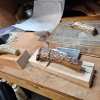
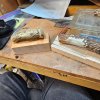
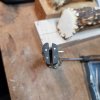
It is so simple I don't know why people don't all do it. - Make a sacrificial cutting sled.
Use glue (hot glue works great) to glue the stag (or any rounded or irregular object) to a flat board, (I use cut-off scraps). I use smaller blocks, but for finger safety, using a wider flat board is wise. Mark the stag with a vertical line that references the cut. Mark a centerline on the wood, and glue the stag on with the two lines aligned. Run the board through the bandsaw or table saw along the fence, cutting the stag and the board into slices as needed. You will get perfectly straight and flat backed slices.
Should work. When you are sanding and you think you are about there, you still got more to do.
I flatten and thin my elk scales on a 9" flat disc with a 60 grit zirc disc. Even with that, take it to where ya think ya should be and then go more. Processed as described in the WIP above:Thanks for the replies y'all.
Unfortunately no bandsaw or table saw access where I'm at, so I'll be doing this with hand power and time. But yes, I wouldn't want to cut anything this small freehand on power tools.
That's good to know. Thank you.


EXACTLY right. Don't scrimp on the size of the sacrificial board - a few inches bigger = better security = more safety. I still prefer the bandsaw for this kind of work but if all you have is a TS that will work too. You just need to upgrade your safety set up and truly keep your wits about you.It is so simple I don't know why people don't all do it. - Make a sacrificial cutting sled.
Use glue (hot glue works great) to glue the stag (or any rounded or irregular object) to a flat board, (I use cut-off scraps). I use smaller blocks, but for finger safety, using a wider flat board is wise. Mark the stag with a vertical line that references the cut. Mark a centerline on the wood, and glue the stag on with the two lines aligned. Run the board through the bandsaw or table saw along the fence, cutting the stag and the board into slices as needed. You will get perfectly straight and flat backed slices.
I use this method to make the slice for my "mountain Man" folders.
 Your added comment confirms that you've got this.
Your added comment confirms that you've got this. 